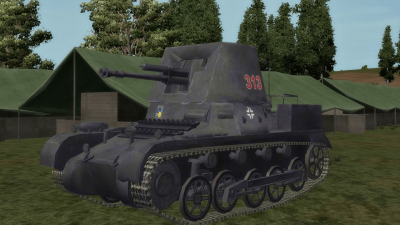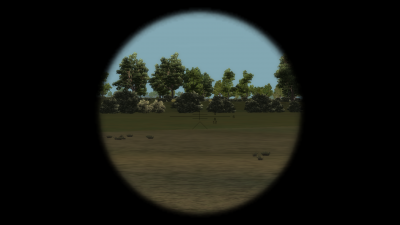Panzerjäger
Panzerjäger I
History

| |
| 'Panzerjäger I | |
| Specifications | |
| Type | tank destroyer |
| Armament | 47mm Skoda VZ 36 L43 |
| Gun Elevation | -8° to +10° |
| gun Traverse | 15° 5° |
| Crew | 3 (Driver, Commander, Gunner) |
| Weight | 6400kg |
| Top Speed | 40kmh |

| |
| Main Gun Optics | |
| Specifications | |
| Designation | ZF-2 monocular |
| Magnification | 2x |
| Field of View | 15° |
The famed Panzer General Heinz Guderian, before the outbreak of the Second World War predicted the need for a mobile self-propelled anti tank vehicle. The German armed forces produced the 4.7 cm PaK (t) (Sfl) auf Pz.Kpfw. I ohne turm in March 1940. This vehicle is better known as the Panzerjäger. It was the first of many different designs of these types of vehicles produced by Germany during the course of the Second World War. During the polish campaign the deficiencies of the pak36 were noted, although it could knock out polish tanks effective it was realised that a more power gun with better penetration would be required for upcoming battle with France and Britain. The Pak38 was only still in the development stage so another had to sought and quickly. Fortunately for the Germans, when they annexed Czechoslovakia they acquired a large number of 47mm anti-tank guns manufactured by Skoda.
Mounting a sufficiently powerful PaK gun on a mobile chassis was more desirable than a towed gun particularly for panzer units, as it would allow the gun to follow the fast-moving units and to quickly change position to engage enemy targets. For these reasons, after the Polish campaign, the Heereswaffenamt (ordnance department) made a proposal to mount the Czech 47 mm gun on a modified Panzer I Ausf.B. tank chassis. The Panzer I was chosen due to the fact is was already obsolete and available in large numbers. A prototype was produced by February 1940 with an order placed for roughly 130 vehicles to be ready for May. The Panzerjäger made it combat debut in the invasion of France. Providing to an effective weapon that could tackle most of the allied armour it faced. However, it struggled to frontally penetrate the heavy allied tanks such as the Matilda II and the Char Bis.
Other issues did arise during the battle of France. Its small size meant that it only had a crew of three and each man had to perform multiple roles for the Panzerjäger to be effective. It had minimal armour protection; the max armour of the chaises was 13mm and the shield 14.5mm. This only really provided protection from small arms fire and being an open topped vehicle the crew were exposed meaning that could easily be killed. Nor did it have proper telescopic sights, meaning that the crew would have to expose themselves to get a bearing in the surrounding or be reliant of what they could see in the gun sight.
Despite these issues the Panzerjäger was to be found wherever the German army fought during the early part of the Second World War, seeing action in both North Africa and on the eastern front. Before being phased out and replaced in late 1942 early 1943. The Panzerjäger successfully proved that a self-propelled anti-tank weapon concept was feasible and effective and lead to a Germans producing a wide range of different types of with varying success.
Game Play
In WWII Online, just like in the real world, the Panzerjagerl is best used at medium range - it has to be close enough to use its 47 mm gun to best effect yet far enough away to keep its pitiful armor away from anything larger than a rifle bullet. Teamwork, as always, makes for a happy tanker. Let the enemy focus on the slightly more survivable panzers up ahead while you cherry pick the toughest targets for them, helping them along. You will need to keep a lookout for enterprising enemy soldiers and not the least aircraft, that may render you hors combat with a single strafe or a lucky grenade.